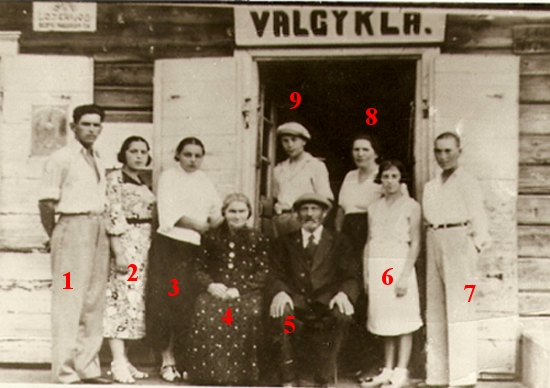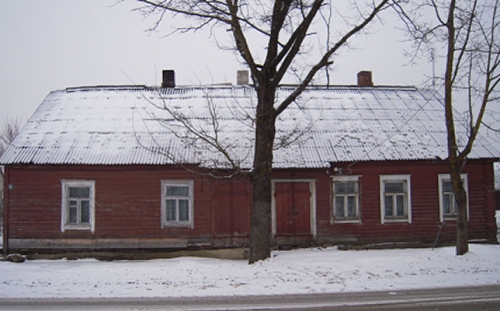|

Fisher Family in front
of their store
|

1 - Shlemke Fisher, 2 -
Henneh, Shlemke's wife, 3 -
Bailkeh Fisher, 4- Sara Shapiro Fisher, 5 - Elihenoch Fisher,
6 - Tybkeh Fisher, 7 - Pesach or Itzhak Fisher, 8 - Sorel Fleishman
Fisher, 9 - Pesach or Itzhak Fisher
The following died in the Holocaust: Pesach Fisher, Sara Shapiro
Fisher. See Uzpaliai Holocaust List
for more information.
(Photo courtesy of Arky Berkal)
The sign on the store says,
in Lithuanian, "VALGYKLA". I asked Vitalijus Karalius,
who lives in Lithuania, for a translation and here is his reply:
The closest I can come to giving you the feeling of what it means is
"dining hall" - but it is a little more nuanced than that.
The word is generally used in describing a communal or factory dining
hall as opposed to a restaurant or tavern.
By way of example, if there was a steel mill in town and there was a
cafeteria that was part of company facilities - that would fit as a
"valgylkla". The word literally means "a place to
eat" but not in the restaurant business sense - think of it more
as a description of "this is where you go to eat".
Not having any more than the picture to go by, I would think that it
is possible that the Fisher family ran the facility or had the
concession for the facility - probably as part of some business
operation in the town. I am not saying that it is impossible that is
was a stand-alone business open to the general public, just that from
the name, that is a less likely possibility.
And this is what "valgykla" translates to according to one
dictionary -
mess canteen coffee-room
cookshop eatery eating-house
lunchroom dining-room refectory
hall mess-room commons


Vitalijus
Karalius went to the trouble of going to Uzpaliai and photographing it for us.
His explanation of what he did and found follows.
"I think I found
it. No guarantees **, but I am reasonably sure. Astiko Gatvė (St.)
24. The Archives would have information on the owners back at
least to the early twenties.
**(According
to a family member in Israel, the building which was the Fisher family
business and home burned down some time ago.)
All the long drawn out theories on the name and location and the end
result is what would probably best be described as sort of a
"roadhouse" or public dining hall for travelers passing
through town. In it's day, probably at the city limits - across the
bridge from the center of town and on the road leading out of town
towards Svedesai. It's not related to any company or business that I
can tell and was a substantial, well built place with a stone and
brick foundation and log walls with a basement and a barn in back.
I first tried to find it on my own, and did. At that point, I went
hunting for some locals who might confirm where such a place might be
based on the use, without telling them what I found or where it was. I
got just such confirmation - the first from a woman in her 70's who
picked the location rather quickly without difficulty or prompting
(without going there) and confirmed that it was the only "valgykla"
in town before the war. Now she seems too young to remember much more
than the mid to late 30's, but I think that's plenty reliable enough.
Across the street from the building, I struck up a conversation with
another lady, quite a bit younger. She pointed out the same building
and said that after the war (late 40's) it was something of a tavern
that also served food - the kind of place wives would have to drag
their husbands home from. So from the locals, this seems to be the
spot that matches what we knew about the building and its general use.
It's in pretty sad shape.
Now the building has had siding put on it over the intervening years,
and you cannot really tell if logs had been cut to add windows, move
doors etc. But that sort of thing (reconstruction) was normally done
by the Soviets. Did not really matter if it made sense, they just did
what they wanted, re-used everything due to shortages. So it would not
be unusual to see the same doors and windows - but not necessarily in
the same spot. The reason I mention this, is that the space between
the doors is less than in the picture you sent. The give away though,
is the treatment above each door. They are the same, and if someone
wants to take the time, I suspect that the proportions of the door on
the right, and possibly both doors will match for height vs width. The
two doors side by side is also very unusual. The typical house of the
period has a single door in the center - and even if there were 2
"apartments" - they would share the entrance. A Jewish
merchant of the time would then usually have double doors at one end -
where the store would be. This one is different - as is the one in
your picture. The older woman said the entrance was from the street,
which would certainly make more sense than putting the sign in the
back, and also pointed out that the whole building was a dining hall.
I understood from that that the owners may not have lived in the same
place, although they might have lived in the loft. In the back of the
building - from the yard side, there is a similar setup, although the
back has been pretty thoroughly "remodeled" and bears little
resemblance to the original. I would surmise that the building may
have once been home to 2 families, and only later was turned into a
dining hall. By the way, we decided that the sign in the upper left of
your picture says "Loterijos" - so in addition to food, they
sold lottery tickets."
| | | | | | | |


